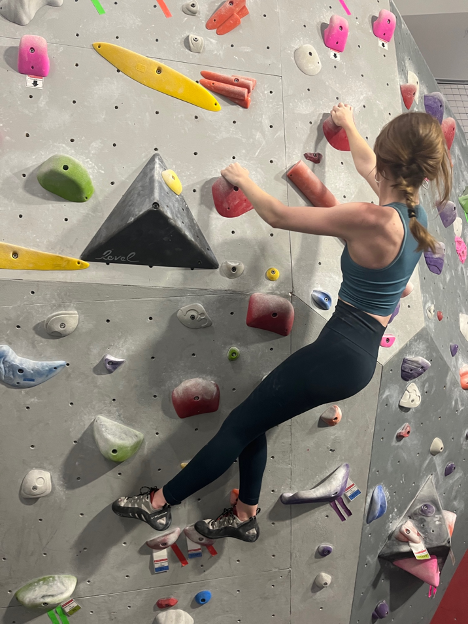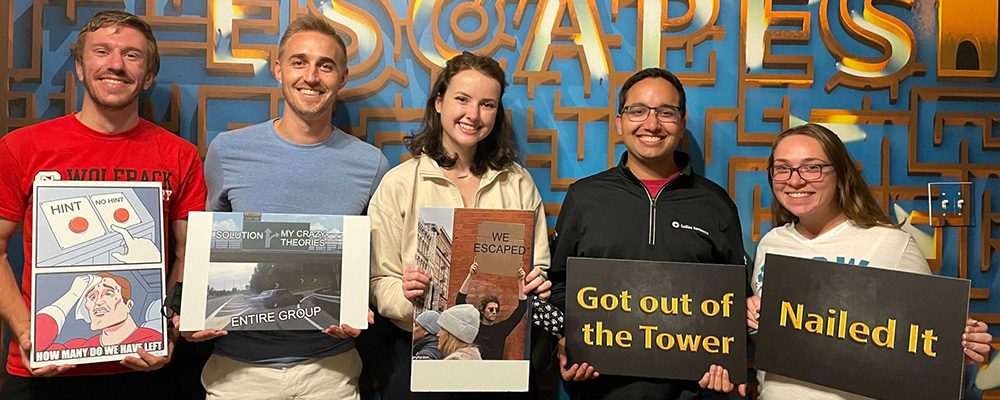
I love rock climbing. Though I’ve only been climbing for about one year, it has quickly become one of my favorite pastimes. Since starting at the Institute in June, I’ve already gained a reputation for being the student who takes any opportunity to ask my classmates if they’d like to come climbing (and subsequently recruit them to at least join the climbing Slack channel).
Why do I do this? Yes, it is because we have fun here at the IAA, but why do I try to bring everyone climbing, specifically? Because I know how intimidating it can feel to try it for the first time, and because I’ve brought countless first-time climbers to the gym and watched their attitudes change from tentative to exhilarated as they see what climbing is all about.
So, whether you’re an experienced climber, an aspiring climber, or an “I think I tried it once at a birthday party when I was nine” climber, I’m here to tell you why you might love it too—especially if you’re a data scientist.
Climbing is the perfect hobby for the active data scientist for three reasons:
- it’s accessible no matter your experience level
- it engages our puzzle-loving & problem-solving minds
- it gives us a chance to spend time together outside of our data-filled days.
Before I elaborate, I’ve compiled a brief climber’s dictionary below that defines a few climbing terms that I’ll be using:
- Beta: information on how to do a route
- Bouldering: shorter-wall climbing without the use of a harness
- Forecasting: examining a route from the ground and planning out moves that you will use
- Projecting: working on a route over multiple attempts until you figure it out
- Route: a specific climbing problem
- Top-Roping: tall-wall climbing where you’re attached to a harness
Now that we’re all warmed up, here’s why you should take a break from that Python script and get on the wall:
#1 It’s accessible no matter your experience level
One of my favorite things about climbing is its accessibility across different experience levels. Any climbing gym you go to will have a variety of routes that range in difficulty from beginner to advanced. As such, no matter your skill level, you’ll always have routes that you can do easily, ones that you can project, and ones that you can aspire to.
Additionally, rock climbing has a community nature unlike that of other workout environments— a stranger isn’t really a stranger in the climbing gym. People are always discussing favorite routes, swapping beta, and cheering each other on.
At a normal gym, interrupting someone’s workout to inquire about their technique might sound rude or downright terrifying. But at the climbing gym, almost anyone would happily respond to your inquiry. Because of this, you’re always learning and improving. Over time, you can measure your progress and see how you rise up the route grades, while still always having routes to project and routes to aspire to. And whenever you feel a bit stuck, odds are that anyone around you would be happy to help you out.
#2 It engages our puzzle-loving & problem-solving minds
To be a data scientist is to love problem-solving, and at its heart, rock climbing is active problem-solving. Whether top-roping or bouldering, each route requires both physical and mental skills to overcome. That mental problem-solving often mirrors the typical analytics thought process:
- Sometimes, we can figure a route out as we climb without much effort. Though oftentimes, we’ll stumble, slip, and have to reevaluate our plan mid-climb (adjust our research trajectory mid-project).
- Other times, we might have to return to the ground to forecast and discuss beta with other climbers (look at our problem from new angles and ask our colleagues for advice).
- Some routes you can get on your first try, some with concerted effort, and some by projecting over minutes, hours, or multiple sessions (some analytics projects will be simple, and some will take us much longer or be much harder than we initially expected).
Not only does this type of thinking come naturally to us, but it also acts as a stress-relieving reminder to enjoy the process rather than have tunnel vision toward the end result. Sometimes it takes a bit more effort than expected to reach that end. What matters is that we have fun with the puzzle, learn and practice new skills along the way, and celebrate when at last we reach that final hold.
#3 It gives us a chance to spend time together outside of our data-filled days
Finally, climbing is a great way for us to destress together outside of the hyper-focus we are sometimes drawn into when working on a particularly engaging analytics problem.
With the IAA climbing outings, sometimes we go for hours, sometimes for thirty minutes, and sometimes even right after our intramural soccer games. We can get a quick workout in, which is great for our physical and mental well-being, while also feeling like we’re simply hanging out with friends.
Whenever we can, we like to get together to try out new bouldering routes. One time, with an especially difficult problem, five of us ended up collectively projecting a route. Each person added a new move to our group beta; the rest of us watched excitedly and encouraged them. When we finally figured out the route, we took turns completing it one by one, celebrating each other and reveling in our shared success.
Climbing creates a strong, celebratory, and collaborative environment that helps us get our energy out, support each other, and spend time together in a way we can all enjoy.
As the program goes on, I will continue asking each of my fellow classmates if they’d like to come climbing sometime. I’ll keep offering, and I’ll keep going myself because ultimately, climbing makes me happy and I love sharing it with others.

If you’re thinking you might like to try out climbing, ask your climber friends or head to your local climbing gym. I’m sure anyone there would love to show you the ropes.
Columnist: Rachel Slover
